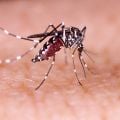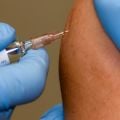New stem cell approach for blindness successful in mice
Blind mice can see again, after Oxford University researchers transplanted developing cells into their eyes and found they could re-form the entire light-sensitive layer of the retina.
Videos show the nocturnal mice, which once didn't notice the difference between light and dark at all, now run from the light and prefer to be in the dark – just like mice with normal vision.
The researchers say the approach has relevance for treating patients with retinitis pigmentosa, a condition in which the light-sensing cells in the retina gradually die leading to progressive blindness.
The study was led by Professor Robert MacLaren in the Nuffield Department of Clinical Neurosciences at the University of Oxford, together with Dr Mandeep Singh, an eye surgeon from the National University Hospital of Singapore who is currently undertaking PhD studies in Oxford. The findings are published online in the journal PNAS.
The researchers worked with mice that are blind due to complete loss of the light-sensing photoreceptor cells in their retinas. This is the most relevant mouse model for treating patients who are blind from retinitis pigmentosa.
After two weeks, the researchers showed the cells transplanted into the eye had re-formed a full light-detecting layer on the retina and the mice could see.
The cells used were mouse 'precursor' cells that are on an initial path towards developing into retinal cells.
A pupil constriction test showed that, of the 12 mice that received the cell transplant, 10 showed improved pupil constriction in response to light. This shows that the retinas of the mice were sensing the light once more, and this was being transmitted down the optic nerve to the brain.
Dr Singh says: 'We found that if enough cells are transplanted together, they not only become light sensing but they also regenerate the connections required for meaningful vision.'
Professor MacLaren explains: 'Stem cells have been trialled in patients to replace the pigmented lining of the retina, but this new research shows that the light-sensing layer might also be replaced in a similar way. The light-sensing cells have a highly complex structure and we observed that they can resume function as a layer and restore connections after transplantation into the completely blind retina.'
In looking forward towards potential cell treatments for blindness in humans, Professor MacLaren explains that they would like to use induced pluripotent stem cells, or iPS cells. These are stem cells that have been generated from the patient’s own cells, such as skin or blood cells, and can then be directed to form precursors of the retina cells.
Professor MacLaren says that this has been achieved by others: 'All the steps are there for doing this in patients in the future.' The next step is to find a reliable source of cells in patients that can provide the stem cells for use in such transplants, he says.
While these are more long-term developments to work towards, Professor MacLaren says 'Our study shows what we could achieve with a cell-based approach.'
'We have shown the transplanted cells survive, they become light-sensitive, and they connect and reform the wiring to the rest of the retina to restore vision,' he says. 'The ability to reconstruct the entire light sensitive layer of the retina using cell transplantation is the ultimate goal of the stem cell treatments for blindness we are all working towards.'
 New study estimates NHS England spends 3% of its primary and secondary care budget on the health impacts of temperature
New study estimates NHS England spends 3% of its primary and secondary care budget on the health impacts of temperature
 International collaboration launches largest-ever therapeutics trial for patients hospitalised with dengue
International collaboration launches largest-ever therapeutics trial for patients hospitalised with dengue
 Oxford-built multi-agent assistant for cancer care to be piloted in collaboration with Microsoft
Oxford-built multi-agent assistant for cancer care to be piloted in collaboration with Microsoft
 World's first Phase II Nipah virus vaccine trial launch
World's first Phase II Nipah virus vaccine trial launch